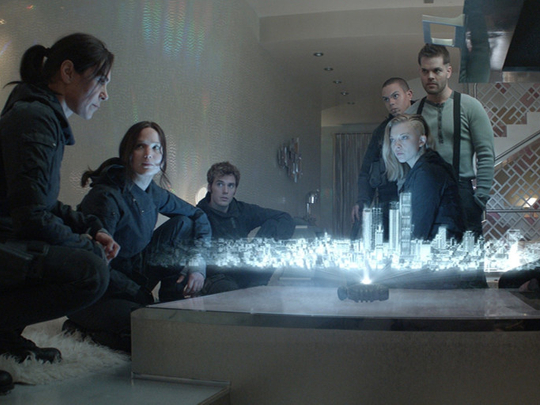
The pressure is on. The endgame is near. There will be blood, brutality, death and scary lizard mutants smashing through a sewer. The final film instalment of Suzanne Collins’ bestselling trilogy, The Hunger Games: Mockingjay Part 2, will reach screens on Thursday, November 19, and millions of fans worldwide will scrutinise the movie for its fidelity to the books; the portrayal (by Jennifer Lawrence) of its intrepid, taciturn heroine Katniss Everdeen; and its evocation of the civil war that rends Panem, the totalitarian state built from the ashes of North America at some unspecified time in the future.
The pressure has always been on for the makers of The Hunger Games films. More than nine million copies of the trilogy were in print in the US by the time the first movie was being planned, and a huge fan base, with very specific ideas about Katniss and her world, already existed. Despite the blockbuster nature of the books, Collins’ dystopian vision of an annual gladiatorial game of wits and weapons in which 24 teenagers — a boy and a girl from each Panem’s 12 districts — must kill one another while the entire population of Panem watches on television, wasn’t an easy one to bring to the screen.
“Many studios just passed,” said Nina Jacobson, who, along with Jon Kilik, has produced the film series from the start. She and director Francis Lawrence, who was responsible for Mockingjay Part 2 as well as the two preceding films, were recalling the often difficult path they travelled to bring the series to fruition.
“Kids killing kids, a young protagonist, female, and what’s with the weird name?” Jacobson said. “I had people saying: ‘Couldn’t you age up the characters? Can we make the love triangle more important?’”
Jacobson, an independent producer, said that she became “fixated” on the series after an employee persuaded her to read the first novel and that she convinced Collins that she would find a studio that would be faithful to the stories’ values.
“Having been a corporate soldier for most of my career, I was very aware of how scared big companies can get down the line,” Jacobson said. “At Lionsgate, everyone was in the room from the beginning and knew exactly what they were in for.”
One of those things was Collins’ uncompromising vision of a heroine who is not friendly, funny, kooky or defined by a man. (“A brilliant, possibly historic creation — stripped of sentimentality and psychosexual ornamentation, armed with Diana’s bow and a ferocious will — Katniss is a new female warrior,” Manohla Dargis wrote in The New York Times review of the first film.)
Still, Jacobson insisted that there had never been any demands to direct the role differently. Francis Lawrence agreed.
“The conventional arc for this kind of movie would have been that she was petrified to go into the games, and learns courage and triumphs,” he said. “Instead she volunteers, is courageous from the beginning and is changed in other ways — and not always for the better. In the last movie, it is her fault that some of the loss of life happens.”
He added that he liked that the love triangle involving Katniss, Peeta (Josh Hutcherson) — her fellow tribute from District 12 — and her childhood friend Gale (Liam Hemsworth) was not at the forefront of the movies or the books. “It’s not about romance, it’s just about survival,” he said.
Lawrence has won plaudits for her Katniss, but her casting initially drew an outcry from some fans of the novels — too old, too blonde, too curvaceous. Yet Jacobson; Kilik; and the first film’s director, Gary Ross, held their ground.
“Jen had and has a very youthful face and quality, and quite honestly from the time we saw her audition, there was no one else that we even considered.” Plus, she added, there was always hair dye.
The decision to split the final novel, Mockingjay, into two parts was made before he came aboard, but Francis Lawrence said he would not have been able to make an adequate version of the book in a single film.
“We got a lot of flak; some people thought it was cynical and moneymaking,” he said. “But I honestly don’t think the changes that happen to people in that book are doable in a two-and-a-half-hour movie.”
Fans may not have agreed; Mockingjay Part 1 earned Lionsgate around $100 million less than Catching Fire. But Jacobson defended the film, saying that it was the darkest of the movies, with difficult themes of war and revolution as well as traumatic emotional events. “We hope that people seeing Part 2 will understand the need for Part 1 better,” she said.
(The cast and crew members suffered their own trauma when Philip Seymour Hoffman, who played the chief gamemaker Plutarch Heavensbee in the final three movies, died suddenly a few weeks before the end of shooting Mockingjay Part 2, in which he appears, though the filmmakers were forced to rewrite some of his scenes for other characters.)













